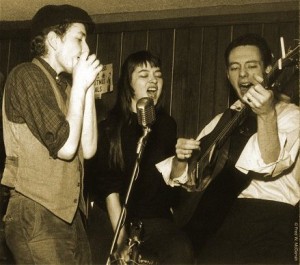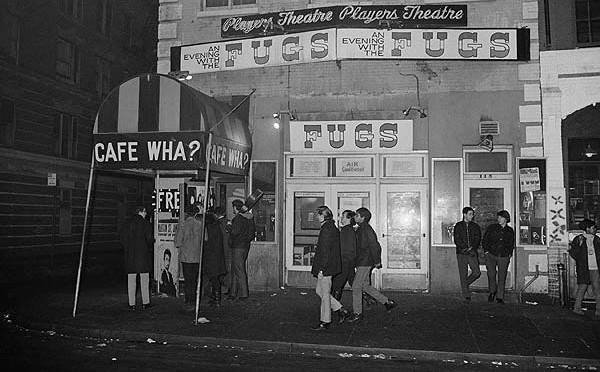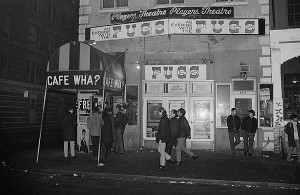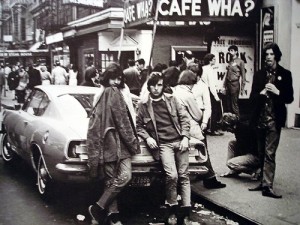FRIDAY NIGHT FEVER To get you in the mood for the weekend, every other Friday we’ll be featuring an old New York nightlife haunt, from the dance halls of 19th Century Bowery, to the massive warehouse clubs of the mid-1990s. Past entries can be found here.
LOCATION Cafe Wha?
115 Macdougal St, at Minetta Lane
Occasionally, the usual types actually did pack into Cafe Wha? — the intellectuals, the progressive, heavy-lidded types. Some of them actually were true beatniks — Sartre, cigarettes and turtlenecks — although most were just regular college students, some hippie precursors mixed among them, or uptowners who were looking to see these so-called beatniks in their natural habitat. They all filtered into this plain, dark room on Macdougal Street, where revolutions were hatched nightly from a guitar or a harmonica.
Cafe Wha?, at 115 MacDougal Street, helped create and then outlived New York’s pre-Vietnam War folk era, providing a stage for performers who would literally make music history.
Wha? was one in a string of Village ‘baskethouses’ as they were sometimes called, small music venues where a small wicker basket would be passed around for tips during performances. The music acts didn’t get paid much; there were dozons of aspiring Woody Guthries in the Village, much of the talent interchangable. Performers would traipse up and down the street, playing several times in different places, sometimes on the street.
Many would stumble into Cafe Wha?’s unassuming, sometimes dingy doorway. The club was owned by Manny Roth, who would open here in the late 1950s. He would own a few nightclubs and lounges over time, including another folk venue Cock ‘N Bull (later to become The Bitter End).
Roth’s lineage would create a different source of musical inspiration in the form of his nephew David Lee Roth, to become the flamboyant frontman of Van Halen. Young David would frequently accompany Manny into the club and would often be left with whatever singer happened to be performing at the time (including, a few times, with Richie Havens.) Little David, destined for tight pants, never stood a chance.
Many of folk’s most talented stars played the small Wha? stage, entertaining both bohemian and uptown audiences eager for new talent. Hilly Kristal, later the owner of New York’s most influential rock club CBGBs, was a burgeoning folk singer who frequently performed here. “Those were fun years, the beatnik era,” he said.
But the kernal of Wha?’s reputation lay with a wan, undistinguished looking boy named Bob Dylan. As the story goes, Cafe Wha? was the very first venue Dylan ever played in New York City, arriving there on his very first day in town on January 24, 1961. He auditioned for Roth, who hired Dylan to play behind one of Roth’s stars Fred Neil, a folkster who would later write songs for Harry Nilsson.
Dylan would only perform as a solo artist at Cafe Wha? only in the afternoons and would perform for free. He would play for bigger audiences at night, but only as backup for Neil.
“I worked for Manny all afternoons, from twelve to eight,” Dylan recalls. “There was constantly something happening on stage. You never really did get popular there, ’cause people never knew who you were….It was just a nonstop flow of people, usually they were tourists who were looking for beatniks in the Village.”
Below: Dylan with Neil and singer Karen Dalton 
According to a biography by Bob Spitz, the odd, gangly Dylan instantly set himself apart. “That voice! Nobody had ever heard anything like it before….Bob had perfected the tonsilly scranch, a dry, throaty tenor ‘with all the husk and bark left on the notes’, which, if you weren’t actually looking at him, sounded like a middle-age hillbilly with emphysema.”
Certainly he was perceived by some as a parody of a folk singer: raggy clothing, offbeat and sincere. He would eventually distinguish himself as a solo star at other venues — most notably over at Gerde’s Folk City, a venue which would launch him to fame.
But in February 1961, he was just second-fiddle to Neil, who wasn’t the only notable headliner on the Wha? stage. Noel Stookey had a successful stand-up routine at the club long before he took the stage name Paul which fit nicely between the names Peter and Mary. However the performer that interests me most was another folk singer who would more lucratively abandon music altogether — Lou Gossett Jr. As in Officer and a Gentleman Lou Gossett Jr., quite a talented and well-known folk musician in the early 1960s.
Like a handful of other Village music spots, Cafe Wha? helped create the soundtrack for New York counterculture, enriched the Village’s rich reputation for the different. By the mid-60s, Wha? would diversify its musical acts. For instance, a New York Times article from 1965 a ‘Beatles backlash’ emanating from the Cafe What basement in the form of ‘modern blues’.
At the suggestion of Richie Havens (who also got his start at Wha?), a young guitar player Jimi Hendrix auditioned for Roth and got a three-month gig here in the summer of 1966, performing with a group called the Blue Flames. Hendrix and the Flames performed funkified covers of popular songs, certainly the most dynamic house band one can possibly imagine. Curiously, Hendrix and Dylan, the two great stars of Wha?, met only once, and it was at another Village bar, Kettle of Fish.
Around this time another rock band The Castiles would frequently perform here. The group would dissolve after a couple years, and its lead singer, Bruce Springsteen, would continue his slow climb to fame.
Roth would continue to operate the club for two more decades, presenting a host of entertainers from comedians like Lenny Bruce and Richard Pryor to definitely-not-folk-acts like Kool and the Gang.
Roth sold Cafe Wha? in 1988 but would go on to own other performance venues like the West End Gate. Cafe Wha? is open today under different management, hosting a roster of rock and soul artists. I’m not sure however if they still pass about a basket.




11 replies on “Cafe Wha?: the whys, wheres, whos and hows”
Cafe Wha actually started in the space that’s now the Comedy Cellar, just up the street. Roth moved it over to the current location in 1966, long after Dylan had abandoned MacDougal St all together.
Photos are really colorful even though it is black and white..
___________________
Andrew
Get your company name famous across the world with online marketing
From June 1962 to September 1963, I and my singing partner (we called ourselves The Waif-Fairers) had a gig at Cafe Wha? (as well as three or four other coffee houses) every Friday, Saturday and Sunday night – passing the basket. It was an inspiring time. Never got to meet Dylan (tho’ we did do a few of his songs), but we did get to know Dave Van Ronk, Peter Torkinson (eventually Tork of The Monkees) and we had the incredible good fortune to get to know Phil Ochs. As a matter of fact, we were the first singers to perform his songs (he even made us a tape talking us through his first 23 songs). Though 48 years ago, the memories of The Village are fresh in my mind. I think it’s time to start singing again.
Mel, my father kept a journal most of his life and I recently read an entry where he says he and my mother visited NYC on the weekend of July 13-15, 1962. I’ve been wondering if I can find out who all played those days, just to know who they may have heard. Do you figure they would have seen you if they went there in the evening? Would others have played too? Any idea who they might have been? Were there daytime shows as well? Anything you might know, or leads, would be great. Thanks!
Steve R
Portland, OR
Mel, I have finished a first draft on a book about Fred Neil. Would like to talk to you if you’re willing. Peter Neff peterneff@comcast.net
The photos you’ve posted show it remaining in its current location. You can look at it on Google Street View. What’s more– I question whether, as Dan said, it was moved to the current location in 1966. A simple news search turned up articles from the NY Times from 1961 noting its location– at 115 MacDougal Street, where it sits today. http://tinyurl.com/6fhr9fe
If memory serves, when I sang there in ’62-’63 it was on the corner of Macdougal and West 3rd.
I just found this article, and I enjoyed reading much of it, but some of your information is incorrect (as tends to be the case with this era in history).
Fred Neil was popular, but not a headliner, and neither was Noel Stookey, although these men did indeed perform at the Cafe Wha. Richie Havens had absolutely NOTHING to do with Jimi Hendrix playing at the Cafe Wha.
“Superman” Victor Brady, who was the main headliner at the Cafe Wha, is the one who got Jimi on the stage, and it is through Brady’s band that Chas Chandler eventually discovered Hendrix at the Wha. Additionally, there was no group called the “Blue Flames” at the time that Jimi went to the Cafe Wha as an unknown performer, begging for a chance at the stage. The complete story is actually quite fascinating.
There is a rich history to the Cafe Wha and many pieces have been left out over the years, but the story of the Cafe Wha in the 1960s cannot be complete without discussing “Superman” Victor Brady. If you are interested in the rest of the detailed history of the Cafe Wha and New York City during the 1960s, contact NYC.history1@gmail.com
Historian, I am doing research about this time and one particular performer for a book. Interested in this period of time and the performers…Victor Brady. Would like to communicate with you.
I know your comment is 12 years old BUT it’s new to me. I walked by the Cafe Wha hundreds of times starting around 1960 (I was 16) I managed to get myself in the door a few times (I usually had very little cash in my pocket and there was usually a ‘cover’ or at least a requirement to buy some cheap drink…for me it was apple cider with a cinnamon stick. Anyway, the few times I got in I saw Superman Victor Brady every time, I was stunned, I’d never seen anything like it. They were fantastic. After about thirty seconds they were all covered in sweat. On a side note, after I smoked my first joint (two years later) my first connection was a guy who hung out right there.. I’d buy six nickel bags of weed for $25 (6 for 5). We’d walk down Minetta Lane and he’d pass me my ‘purchase’. One day we was gone, never to be seen again. Too bad there’s no video somewhere of SupermanVB.
Anyone knows if the two guys behind the Mustang (??) are members of a band that performed at the Wha? Who took the picture?